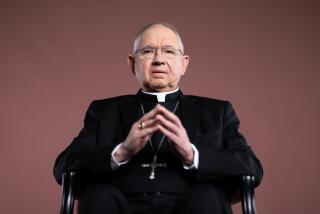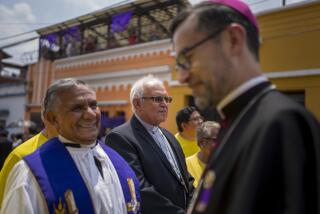Pope Names Central American Saint
- Share via
GUATEMALA CITY — Pope John Paul II canonized Central America’s first saint, a 17th century Spanish missionary, in an outdoor ceremony Tuesday witnessed by half a million faithful, capping a visit to help heal Guatemala’s rifts and stem losses to a powerful evangelical Protestant movement.
Visibly struggling against fatigue, arthritis and the effects of Parkinson’s disease, the pontiff canonized Pedro de San Jose Betancur in a three-hour ceremony conducted on an altar built on an abandoned racetrack and bedecked with thousands of white roses.
“I do it convinced of the relevance of his example, a man who crossed the Atlantic to help the poor, the indigenous people of America, his only baggage his faith in God,” the pope said in a homily that was often slurred or inaudible. The new saint, known here as Hermano Pedro, or Brother Pedro, is the 463rd the pope has named since his papacy began in 1978.
John Paul arrived in Mexico City late Tuesday, the last stop on an 11-day North American tour, to add another name to the list of saints: Juan Diego, a Mexican Indian to whom, according to legend, the Virgin of Guadalupe appeared in 1531.
Mexican President Vicente Fox and 32 children in traditional clothing, one from each of the nation’s states, greeted the pope at the airport. Thousands of Mexicans pointed flashlights into the sky to welcome John Paul’s plane as it approached the capital, and hundreds of thousands lined his 25-mile motorcade route.
The ceremony in Guatemala City, framed by a powder-blue sky and volcanoes swathed in clouds, was intentionally conducted on a massive scale.
Protestantism has made deep inroads in Guatemala over the last several decades, broadcasting on 100 radio and two television stations and employing legions of missionaries--including many from evangelical churches in California. As much as 30% of Guatemala’s population has been converted, the highest percentage of non-Catholics in Latin America, according to Harvard University professor Rachel McCleary.
The other subtext of the pope’s visit was lingering antagonism between the church and the Guatemalan government. The 1998 killing of Bishop Juan Jose Gerardi after the release of a study he led on human rights abuses is still considered by many Catholics to be unsolved despite the convictions of a priest, a former presidential bodyguard, a retired army officer and his son. Many Guatemalans believe that those who planned the attack have not been brought to justice.
Underscoring the tensions, Archbishop Rodolfo Quezada Toruno invoked Gerardi’s name during his remarks welcoming the pope, describing the bishop as a martyr whose example should not be forgotten.
Although a 1996 peace accord ended 35 years of guerrilla warfare in Guatemala, the number of human rights abuses in the nation is rising again, according to University of Illinois professor Bruce Calder. The Catholic clergy is receiving an increasing number of threats both for mediating current conflicts and for its effort to catalog past abuses.
But social and political upheaval were far from the minds of many of those who came to Tuesday’s ceremony, an event attended by President Alfonso Portillo as well as heads of Central American nations El Salvador, Panama, Nicaragua and Honduras.
Portillo announced that, in response to a request from the pope, he was temporarily halting executions and that he would submit a bill to Guatemala’s Congress to abolish the death penalty. A similar request by the pope during his first visit to Guatemala, in 1983, was ignored by then-dictator Efrain Rios Montt.
The pope’s feeble state on this, his third visit to Guatemala, did not lessen the fervor of pilgrims.
“The pope is near to God, and he transmitted that to us, to the hearts of everyone in Guatemala City,” Isabel Bolanos, a Guatemala City housewife, said as she left the outdoor Mass. “We will have lots of blessings now because of his visit.”
Brother Pedro was a Franciscan monk who came to Guatemala from his native Canary Islands in Spain. He dedicated his life to serving the infirm, the poor and the abandoned. Unlike Juan Diego, whose existence many scholars doubt, historical and archival evidence remains of the new saint.
Parts of the colonial capital city of Antigua, where Brother Pedro lived and died, are testimony to his works. The hospital and hospice compound he founded for the sick and abandoned is going strong three centuries later. It has 800 patients, the most recent a 7-month-old foundling left Sunday on the hospice chapel’s doorstep.
Harvard’s McCleary said Protestant evangelicals have seized the initiative in Guatemala. Some indigenous communities, which make up half of Guatemala’s population, became disillusioned with the Catholic Church during the civil war because it was silent or ineffective in stopping the violence, she said.
“The pope is trying to regain Catholics by bestowing sainthood on local people,” McCleary said. John Paul’s three-day visit to Mexico, where Protestant faiths are also gaining ground among Indians and other Catholics, has the same aim. Today he is to make Juan Diego the Americas’ first indigenous saint, and Thursday he will beatify two Catholic Indian martyrs of 1700, placing them a step from sainthood.
The pope, visibly weary after his flight, used a hydraulic lift to descend from the plane and was wheeled on a platform to greet 3,000 well-wishers packed into an airport hangar. They threw confetti and sang songs celebrating his four previous visits to the overwhelmingly Catholic country.
In a brief arrival speech, John Paul urged Mexicans to remain true to Catholicism and repeated the slogan of his previous pilgrimages here: “Mexico ever faithful.”
Times staff writer Richard Boudreaux in Mexico City contributed to this report.
More to Read
Sign up for Essential California
The most important California stories and recommendations in your inbox every morning.
You may occasionally receive promotional content from the Los Angeles Times.










